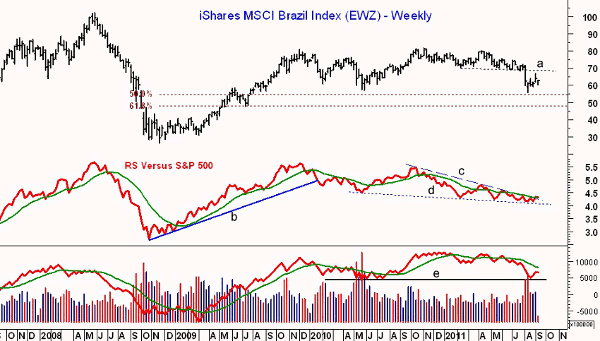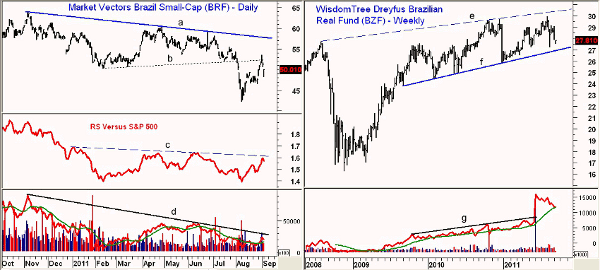Emerging markets often bottom ahead of the developed markets, and if Japanese investors are right, these ETFs that focus on Brazil may present some interesting investment opportunities.
Recent data from Lipper Financial indicates that in the past two years, Japanese investors have invested more than $100 billion in mutual funds tied to the Brazilian economy. The past few months have been quite hard on these investments, as the move out of higher-risk assets has hurt emerging markets.
The currency markets have not helped. The carry trade made the Brazilian real attractive to the Japanese, who could borrow at 0.1% in Japan and get 12.5% in Brazil.
The recent sharp rise in the yen, and fall in the Brazilian real, has dampened this enthusiasm. The prevailing wisdom is that the yen would have to get much stronger to cause significant unwinding of this position.
The recent rate cut in Brazil caught the markets by surprise, as inflation has risen sharply for the past 12 months. It is hoped that the cut will help the Brazilian economy stay strong as concerns grow over a global economic slowdown.
Often, emerging markets will bottom out ahead of developed markets, so I am closely watching the technical action of the Brazilian markets.
Chart Analysis: This long-term chart of the iShares MSCI Brazil Index (EWZ) covers both the bear market of 2008 and the start of the new bull market. EWZ made a high of $80.93 in 2009, and has traded sideways to lower since, despite a marginal new high of $81.76 in 2010.
- EWZ broke key support, line a, in late July, and came close to the 50% Fibonacci retracement support level at $55 in August
- There is a band of good chart support between $55 and the 61.8% support at $48.20
- The weekly relative performance, or RS analysis, along with its 21-week moving average (MA) has done a good job of signaling when one should be in or out of EWZ
- In the summer of 2008, the trend in the RS changed, as EWZ dropped from $88 to under $30. By early 2009 the RS had bottomed, and the uptrend, line b, stayed intact until early 2010
- The RS has been locked in a trading range and has formed moderately lower lows, line d. The RS is slightly above its downtrend (line c) and its WMA, but a new uptrend has not yet been formed
- The weekly on-balance-volume (OBV) also helped to identify the 2009 lows and is now trying to hold support at line e. It is still below its declining WMA
NEXT: 2 More Brazil ETFs to Watch
|pagebreak|The Market Vectors Brazil Small-Cap (BRF) is a $900 million ETF that yields 1.4% and should be more sensitive to an economic turnaround in Brazil. From a low of $42.14 on August 5, BRF has rebounded 27% to a high last week of $53.51.
- BRF rallied back last week to its former support, now resistance at line b
- There is a band of stronger resistance in the $55-$57 area
- The daily RS analysis has risen sharply in the past three weeks, but is still below the key resistance at line c. A convincing move above this level is needed to confirm a bottom
- The daily OBV is still below its long-term downtrend, line d, and shows no signs yet of a major bottom
The WisdomTree Dreyfus Brazilian Real Fund (BZF) is a $500 million ETF that has an average volume of 140,000. It has an income yield of 5.9%, but paid a distribution of $3.24 in 2010.
- The weekly chart shows that BZF has recently come quite close to its weekly support, line f, in the $27 area. The August low was $27.21
- There is further support at $25.80, and a weekly close below this level would violate the uptrend
- The weekly OBV surged to the upside, as volume topped $9 million for one week in June
- The daily OBV (not shown) is neutral
- There is initial resistance now at $28.30-$28.50 with further in the $29.20-$29.45 area
What it Means: The large commitment to Brazilian markets by Japanese investors is interesting, as they tend to take a long-term view. If you believe that we are starting another recession, then emerging markets are likely to again bottom first. Of course, the emerging markets could go lower first.
Technically, equity ETFs should see a pullback back to the August lows, or lower, before a bottom can be formed.
The WisdomTree Dreyfus Brazilian Real Fund (BZF) does look attractive at current levels, due to its healthy dividend and its closeness to long-term support.
How To Profit: For the WisdomTree Dreyfus Brazilian Real Fund (BZF), go long at $27.48 or better, with a stop at $25.68.























